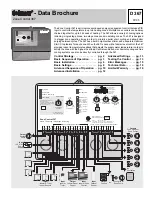
12
Advanced Installation
This section supplements the basic installation that begins on page 6.
Sensor and Unpowered Input Connections
Do not apply power to these terminals as this will damage the control.
Floating Action RTU and Indoor Sensor Connections
It is best to start the Floating Action heating zones at output relays
1 and 2 and work
towards output relays
5 and 6.
Common Block for
RTU 1 and RTU 2
If the
Com 1-2 (19) common block is used for a floating zone, connect the RTU or
Indoor Sensor to terminals
Com Sen — RTU 2 (5 and 7).
Common Block for
RTU 3 and RTU 4
If the
Com 3-4 (22) common block is used for a floating zone, connect the RTU or
Indoor Sensor to terminals
Com Sen — RTU 4 (8 and 10).
Common Block for
RTU 5 and RTU 6
If the
Com 5-6 (25) common block is used for a floating zone, connect the RTU or
Indoor Sensor to terminals
Com Sen — RTU 6 (11 and 13).
Output Connections
Ventilation
If the DIP switch is set to
Zone 2 Ventilating, connect the 24 V (ac) or 120 V (ac) isolation
relay to the
Com 1-2 — 2 (19 and 21) terminals.
Free Cooling
If the DIP switches are set to
Zone 1 Cooling and Zone 2 Ventilating, the wiring diagram
on the previous page can be followed for connecting the free cooling damper(s) and
fan(s) to the control.
Floating Zones
Common Block
Com 1-2
If the
Com 1-2 common block is used to control a floating action zone valve, wire one
side of the 24 V (ac) circuit to terminal
Com 1-2 (19). The output relay 1 (terminal 20)
is then connected to the open terminal on the actuating motor and the output relay
2 (terminal 21) is connected to the close terminal on the actuating motor.
Common Block
Com 3-4
If the
Com 3-4 common block is used to control a floating action zone valve, wire one
side of the 24 V (ac) circuit to terminal
Com 3-4 (22). The output relay 3 (terminal 23)
is then connected to the open terminal on the actuating motor and the output relay
4 (terminal 24) is connected to the close terminal on the actuating motor.
Common Block
Com 5-6
If the
Com 5-6 common block is used to control a floating action zone valve, wire one
side of the 24 V (ac) circuit to terminal
Com 5-6 (25). The output relay 5 (terminal 26)
is then connected to the open terminal on the actuating motor and the output relay
6 (terminal 27) is connected to the close terminal on the actuating motor.
Test the Outputs
Test the sensors, power supplies, system pump, cooling and on / off zones according to the procedure given on page 9.
Ventilation
If output relay
2 is used to control a ventilation system, make sure power to the ventilation unit is off and install a jumper between
the terminals
Com 1-2 — 2 (19 and 21). When the ventilation circuit is powered up, the ventilation system should turn on. If it does
not, check the wiring between the terminals and the ventilation unit and refer to any installation or troubleshooting information
supplied with the fan.
Free Cooling
If output relays
1 and 2 are used to control a fan and damper, make sure power to the free cooling system is off and install jumpers
between the terminals
Com 1-2 — 1 (19 and 20) and Com 1-2 — 2 (19 and 21). When the circuit is powered up, the free cooling
system should turn on. If it does not, check the wiring between the terminals and relays and also check the wiring to the fan and
damper. Refer to any installation or troubleshooting information supplied with these devices.
19
20
21
1
22 23
3
4
25
5
26
24
Com
5-6
27
Com
1-2
2
Com
3-4
6
RTU
5
12
13
RTU
6
11
Com
Sen
RTU
2
7
RTU
3
9
RTU
4
10
8
Com
Sen
26 27
5
6
25
Com
5-6
Com
Sen
5 6
RTU
1
11
Com
Sen
RTU
2
7
RTU
3
9
RTU
4
10
8
Com
Sen
23 24
3
4
22
Com
3-4
19
20 21
1
Com
1-2
2
Com
Sen
5
6
RTU
1
11
Com
Sen
RTU
2
7
RTU
3
9
RTU
4
10
8
Com
Sen
19 20 21
1
22 23
3
4
25
5
26
24
Com
5-6
27
Com
1-2
2
Com
3-4
6
19 20 21
1
22 23
3
4
25
5
26
24
Com
5-6
27
Com
1-2
2
Com
3-4
6
19 20 21
1
22 23
3
4
25
5
26
24
Com
5-6
27
Com
1-2
2
Com
3-4
6


































